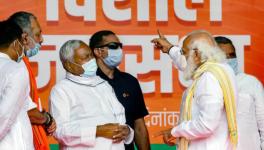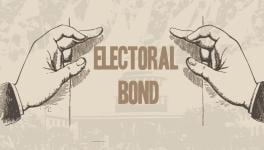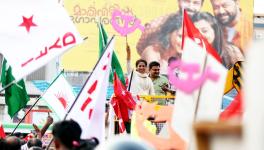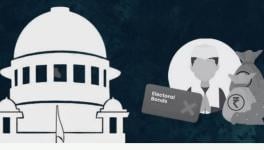History Myth Busting Series - V: Is India the Mother of Democracy?
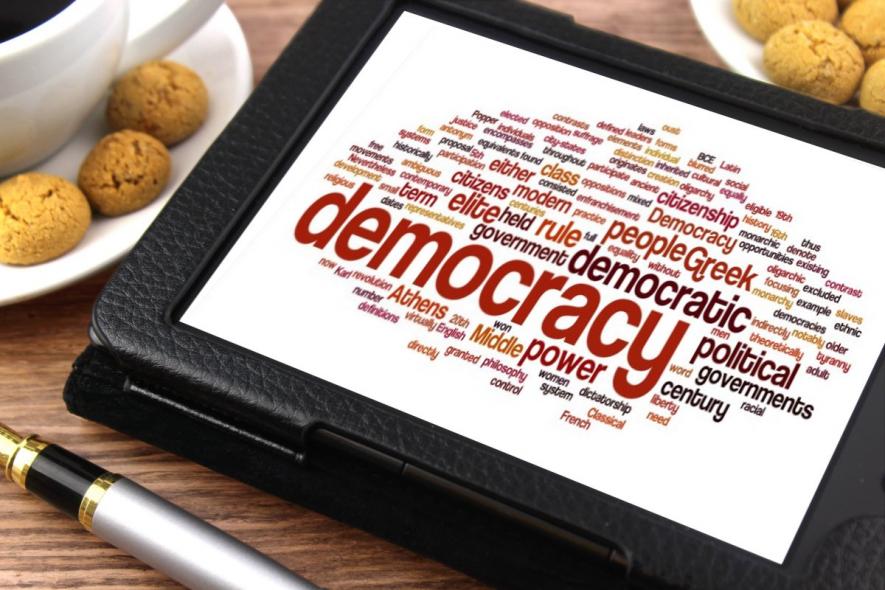
Image Courtesy: The Blue Diamond Gallery
In past few years, many debates and contentions about history have moved from the academic sphere and entered a wider public forum. A battleground has emerged where particular cultures, narratives and ideologies are pitted against others to prove one as dominant and superior to others. The Hindu Right is a major proponent of many such false narratives which aim to establish a particular version of Hindu culture and ideology as the sole and rightful heir to India’s varied history and culture. Such false narratives abandon what the academic world has established through evidence, and they rely on getting traction through popular media, including social media. NewsClick is publishing a series of brief explainers based on evidence-based scholarly research that counter some of these prominent myths propagated by Hindutva forces. Parts 1, 2, 3, and 4 of this series can be read here, here, here, and here, respectively.
The origins of democracy as we understand it today have a varied history. At the moment, we see that certain prominent groups are advocating for India to be a centrepiece of this history. They claim that India is the ‘mother of democracy’. We see the propagation of this narrative not just within India but also on the world stage.
On March 29, 2023, Prime Minister Narendra Modi stated, “The idea of elected leaders was a common feature in ancient India, long before the rest of the world” and that “there are also many historical references to republic states in ancient India where the rulers were not hereditary. India is, indeed, the mother of democracy” while addressing the Summit for Democracy. Others make statements like, “based on numerous strong evidence and solid facts, it can undoubtedly be said that not only did democracy exist in ancient India, but many republics also established their ideal form and structure”. We shall look at the proposed evidence and examine whether it truly worked along democratic lines.
First, it is essential to establish the current conception of democracy. According to the United Nations Human Rights Commission, there are certain essential features of any democracy. These include holding periodic free and fair elections by universal suffrage and by secret ballot as the expression of the will of the people, respect for human rights and fundamental freedoms, freedom of expression and opinion, and a pluralistic system of political parties and organisations. According to the Universal Declaration of Human Rights, the central feature of democracy is that “the will of the people shall be the basis of the authority of government”.
The modern conceptions of democracy and its development are linked to two key revolutions. First, during the American Revolution (1765 – 1783 CE), we see an explicit usage of the word ‘democracy’ in the various debates taking place regarding the suitable form of government, as highlighted in Merril Jensen’s paper. According to the paper, by this point, the idea of democracy was understood as “a government held by the free and voluntary consent of all, or the greater part of the free inhabitants”.
Second, the French Revolution (1789 – 1799 CE) gets the credit for introducing and further developing notions, such as the consent of the governed, principle of popular sovereignty, as well as universal manhood suffrage. Prior to these revolutions, we do not find these concepts in such form. However, the question of whether there were partial or even transitory conceptions of democracies does come up within this discussion and thus needs to be examined.
Athenian democracy is popularly understood as a major origin point of our current conception of democracy. It was also a contemporary of what is considered ‘democracy’ in ancient India. This makes it important to do a comparative analysis and understand how Athenian democracy functioned.
We have a direct understanding of how Athenian democracy worked due to the existence of texts such as the Constitution of the Athenians, which was composed by Aristotle. Unlike modern democracy, universal suffrage was not the norm in Athens. Instead, only elite adult males with Athenian parentage on both sides were considered citizens eligible to vote. Women and slaves were disqualified.
There was also no official class in Athens; the electorate and government were one and the same. Once a citizen of Athens was 20 years old, he would be part of the Popular Assembly and could give a personal vote on all matters of the state.
Another essential feature of Athenian democracy, according to an article in the journal HISTORY, is that it “left little or no room for the ascendancy of the expert and endeavoured to reduce politics to a mere matter of common sense”. As we can see here, Athenian democracy doesn’t quite hold up to our modern conceptions of democracy. In this case, democracy was still in its infancy.
Within the Indian context, the earliest civilisation that we can look at for signs of a state or style of rule is the Indus Civilisation. According to certain propagators, the Indus Civilisation was “based on a proto-democratic notion of equality and co-existence. This idea of the pre-historic people permeated to the later generations, paving the ground for a democratic society which was powerful enough even to cause a change of heart in such ruthless rulers like Asoka in later years”. They attempt to support this conclusion by citing the well-planned nature of the Indus cities, the uniformity of weights, measures, size of bricks and the absence of archaeological evidence of weapons and palace-like structures as signs of a peaceful, cooperative, and oligarchic administration with people’s participation.
Within academia, there are various theories and debates regarding the nature of the State within the Indus Civilisation. According to Adam S. Green, there are two paradigms by which we can understand the prominent positions within these debates. The first one is the “stateless” paradigm, which uses the absence of political centralisation and hierarchy to argue that the Indus Civilisation was not State-based and was instead an amalgam of chiefdoms.
The other is the “state-level” paradigm, which suggests that the lack of evidence for a ruling class is the result of shortcomings in archaeological excavation and recording. Both of these paradigms lead to the concept of heterarchy. This is a form of management or rule in which any unit can govern or be governed by others, depending on circumstances, and, hence, no one unit dominates the rest.
Green goes on to make the claim that the Indus Civilisation was egalitarian and without a ruling class.
On the other hand, historians, such as Jonathan Mark Kenoyer, argue that there was a ruling class of elites belonging to different cities and groups.
Overall, from the evidence that we currently have access to, we cannot make as bold a claim as the Indus Civilisation being a democratic one. The current available archaeological evidence is open to different interpretations by different historians. We have no direct evidence regarding the Indus state. To properly understand how the Indus state operated, we would need to be able to understand their script to access their writings and records. Even then, we have no extended surviving texts that could reveal the nature of the Indus state.
Later on, the gana and samgha are cited as the two popular examples of ancient democracy. These two terms have been interpreted in various ways by different scholars. They have been translated as meaning republic, oligarchy, democracy, confederacy, and so on. These would have existed sometime between 500 BCE and 400 CE. We are limited in our understanding of these ‘republics’.
In most cases, we don’t know much about them apart from their names. They are termed as ‘tribal republics’ mainly because they did not follow the monarchical system of government. The Malavas and Yaudheyas are well-known examples of these tribes. It is through numismatic evidence that historians primarily derive knowledge regarding these tribes. These coins contain legends that can be understood as either personal names and titles or attempts to reproduce a complete legend. By examining terms and titles inscribed on the coins issued by these gana-samghas, historians have been able to establish that these tribes were non-monarchical.
According to A.S. Altekar, these tribal oligarchies flourished as long as there was harmony and concord among the members of their assemblies. These members were generally the senior elite males within the tribe. They were not elected; they were instead given that position due to their popularity and being highly regarded by the public. However, within these assemblies, various subgroups formed, which would often come in conflict with each other. This infighting would often lead to their downfall.
We see a possible element of this infighting in the prophecy given by the Buddha about the Licchavi Republic. According to the Buddha, this republic would only prosper as long as the members of the oligarchy “meet frequently, show reverence to age, experience and ability, transact the sate business in concord and harmony and do not develop selfish parties engaged in eternal wrangling for their narrow and selfish ends”.
Once again, there is no certainty in regard to how exactly they operated and functioned. These forms of assemblies gradually disappeared in the post-Vedic period. Altekar explains that this is “because the state became bigger and bigger in size, rendering the meetings of a Central Assembly more and more impracticable… its members would have had to spend several weeks in reaching the capital in order to attend the Assembly meetings, and an equally long time in returning to their homes”.
It is clear by now that the forms of State and governance that are often being cited as being ‘democratic’ are vastly different from how democracy is conceptualised and understood today. These ‘proto’ forms of democracy lack many of the essential characteristics by which democracy functions today. Within Athenian democracy and the ganas and samghas, we see limited participation in the decision-making processes. Universal manhood suffrage, let alone universal adult suffrage, did not exist. Instead, it was the group of elites that ultimately held political power.
The territory and extent of these democracies were limited as well, with the Athenian democracy limited to a particular city while the tribal oligarchies failed to sustain themselves as their societies and states expanded. It is in the absence of clear and direct evidence that conjectures regarding the ‘democratic’ nature of the Indus state as well as the ganas and samghas are made.
These attempts to find instances of democracy and democratic values in our distant past arise in the context of our contemporary democratic crises. By stating that “democracy is in our DNA”, a clear attempt is being made to justify and sideline shortcomings in the present.
Claiming India as the ‘mother of all democracy’ is an attempt to demonstrate that we are masters of democracy who are inheritors of seemingly ancient ‘democratic’ traditions. If this is the case, how can the present leaders be wrong in any way when handling issues of democracy? Rather than justifying the present by making claims about the past, the current shortcomings of democracy that we face today need to be openly addressed. Otherwise, we might become like the oligarchies of the ancient past.
The writer is an intern with NewsClick. The views are personal.
Get the latest reports & analysis with people's perspective on Protests, movements & deep analytical videos, discussions of the current affairs in your Telegram app. Subscribe to NewsClick's Telegram channel & get Real-Time updates on stories, as they get published on our website.










